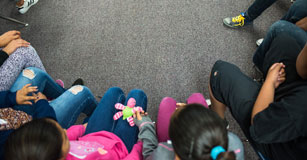Strategies for an Effective Technology Implementation
From pre-purchase to year three workshops, deploying new technology tools for maximum impact

Success starts before you buy
Just because a new device or app has been made available to everyone doesn’t necessarily mean it will be implemented well. The implementation process should begin long before any technology tool is purchased, installed, and used with students.
Begin the process by determining what outcomes you want to see, and then work to refine, clarify, and articulate what success looks like. Once you can articulate what students and teachers will be able to do, you can begin determining what you need to purchase to make that a reality.
In 2008, Forsyth County Schools in Cumming, Georgia, decided to pilot inquiry-based learning at two schools with the goal of moving student learning from basic knowledge recall to higher-order thinking skills. They would assess the pilot’s success as each of the 2,400 students created their own project — choosing a question to answer, researching it, drawing conclusions, and demonstrating how those conclusions were reached.
Forsyth then began the process of selecting tools students could use to meet this goal. They created a list of characteristics an application should have to support students in this fledgling inquiry-based environment. They asked a variety of stakeholders to explore the marketplace and examine the tools available to identify products that were consistent with their goals. Jill Hobson, Director of Instructional Technology, shares, “It was this feedback and decision-making process that helped us decide to use Pixie use in our pilot.”
Hilliard City Schools in Columbus, Ohio, identifies tools in advance by “trail blazing” with a small group of representatives from elementary and middle schools to explore, evaluate, and recommend different programs. They focus on finding flexible technologies that students can use for a variety of purposes, basing their choices on their own successful experiences with the tools. Rich Boettner, Director of Technology, explains, “Most of the technologies we have invested in are intended to be used by our students daily. With limited funding, we want to maximize our technology investment.”
Piloting technology tools may be as much art as science. The people who always volunteer may help your pilot achieve success, but including hesitant or resistant teachers as well as early adopters can give you a better predictor of future success. Including a range of students in a pilot will help determine the degree to which the tool will be adopted organically, and how much you will need to supplement that natural growth with professional development and coaching.

Getting teachers and students on board
After you have chosen devices and apps, made your purchase, and deployed the new tools in your schools, you have a small window of time to lay the foundations for lasting change. In the first three to four months of use, you need to clearly define your goal for improving student learning and explain how the technology tools will help you reach it. Educational consultant Bernajean Porter describes this opportunity zone as the “exciting time when you get to help shape the way students and teachers think about the tool and how they might use it.” She maintains, “Once a tool has been in there for a couple of years, you have an established culture that isn’t going to change.”
We all know that a single workshop is not enough to ensure the correct use of any technology tool. For effective integration to occur, there must be sustained professional development and support.
In 1998, Virginia Beach City Public Schools (VBCPS) began a Computer Resource Specialists (CRS) program to place an instructional technology staff member in each school. A CRS has four major areas of responsibility: instructor, instructional partner, program manager, and technical support. CRS’s aren’t lab teachers or helpdesk staff – they are partners that every teacher in a building can work with to effectively use technology.
When a new technology tool is introduced in Virginia Beach schools, the CRS and LMS (Library Media Specialist) are trained first. They become responsible for training teachers to effectively integrate it into the curriculum. Joan Schlegelmilch, Instructional Technology Coordinator, explains, “We depend on the CRS and LMS to provide site-based training and daily integration support for their staff members.”
Chesterfield County Public Schools in Richmond, Virginia, organizes its “Integrators” by grade–level knowledge and subject area expertise (Language Arts, Mathematics, Science, History and Elective Areas). Fred Scott, the Instructional Technology Coordinator, expects his team “to guide and instruct our teaching staff to integrate technology into classrooms based on student and curriculum needs.”

These instructional technology positions improved integration so much that, in 2004, the Virginia General Assembly authorized funds to support one Instructional Technology Resource Teacher (ITRT) for every 1,000 students across the entire state. It also funded a technology support staff member to maintain the technology, so that the ITRT position could focus on changing instruction.
Changing instruction to focus on student learning is the real goal. Eric Wonsidler, a Technology Integration Specialist (TIS) at Parkway School District in Chesterfield, Missouri, describes his role as a partnership with teachers. He shares, “We look at curriculum and see where technology fits. Sometimes I begin with ideas and samples, but most often we start with their ideas and together we work to develop a lesson that connects to our grade–level learning goals.”
The team at Parkway also works with the curriculum coordinators to write technology tasks, like Pixie activities, into the Stage 3 learning plans that are part of the district’s Understanding By Design curriculum framework. Tom Swoboda, Instructional Technology Coordinator at Parkway, explains, “Our TIS’s are master teachers first of all, and experts in technology integration second. Their goal is to help teachers and students meet curriculum objectives, not to use technology.”
Responsibilities of an Instructional Technology Resource Teacher (ITRT) include:
- Working collaboratively with individual teachers or groups of teachers to integrate technology into instruction
- Assisting with curriculum and content development
- Disseminating information regarding technology resources, emerging technologies, best practices using technology, and professional development opportunities
- Facilitating or conducting technology-related professional development for school staff
- Assessing levels of teacher and student technology use and skills
- Modeling effective instructional strategies using technology
- Serving as a member of the school technology committee
- Supporting implementation of the division and state technology plan
- Researching use of newer technologies in instruction
- Using data to design technology-based instructional strategies
- Recommending hardware, software, and related resources
- Identifying trends in software, curriculum, teaching strategies, and other educational areas
- Creating learning resources for teachers, staff, and students
- Serving as a strong advocate for technology integration
- Participating in software selection and use
If you don’t have continuous funds for a position like this, you can still move forward with your technology integration goals. Despite having one of Colorado’s lowest per pupil funding rates, Poudre School District continues to have a strong vision for integration and has worked with its community and school district foundation to fund that vision.
In 2008, Poudre developed a Digital Educator Program (DEP) to provide a more systematic approach to staff development. The program was funded by a variety of one-time funds, grant money, and the school district foundation. The funding included pay for substitutes so that participating teachers could leave for three days of training that included integration ideas and strategies for various technology tools, but focused on using the Understanding By Design model to write effective lesson plans to go with technology.
In exchange for their time and work on the lessons, each teacher got to choose $3,000 worth of equipment to outfit their classrooms, including tools like document cameras and applications like Frames for digital storytelling projects. The teams met once a month to share and celebrate student work and explore new ideas, developing a strong professional learning community.
The program targeted the fourth grade, requiring buy-in from every member of the teaching team at each school. Getting the entire team into the process meant that many late adopters, who were also master teachers, were introduced to the technology more quickly than they might have otherwise been… with great results. Instructional Technology Coordinator Ben Johnson shares, “Our resistors and technophobes really embraced the trainings and have become some of our best users and advocates.”
The Poudre School District Foundation learned that spending money on both equipment and professional development helped ensure a return on their investment. After seeing such positive results, they are open to supporting additional implementation projects that follow the DEP training model.

Celebrating and expanding success
To showcase the great work done by students, Parkway School District developed a Digital Film Festival. Each year, students submit videos to the festival. Selected videos are shown at a 1,600–seat auditorium at Logan University, with students walking the red carpet to their video premieres! This celebration of the curriculum demonstrates to family and community what student learning at Parkway looks like.
More than just a celebration, the film festival provides students with an opportunity to connect their studies to real-world applications as they develop informational videos, documentaries, and persuasive public service announcements. Work on these films strengthens reading, writing, and 21st century communication skills and requires students to plan, analyze, and interpret results. The film festival also encourages teachers who haven’t worked with technology to try something a bit different.
We often forget to let our students, families, and communities see what is happening in our classrooms. Whether we share student performances through morning video announcements, slide shows, presentations, newsletters, or the Web, it is important for students to publish this work for a wide audience. This allows both our communities and our students see the value in the work we are doing in our schools.
As you look to deploy new technology tools and work to ensure integration is a success, remember that it all starts with a strong vision. Once that is in place, you can focus on how you will build capacity with the tool, provide for its care and maintenance, and celebrate your successes in ways that make sense for the size of your district or budget.
















